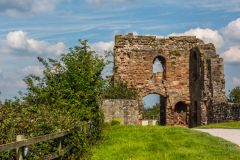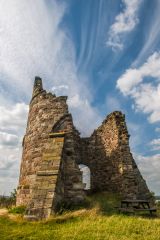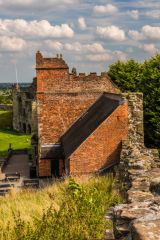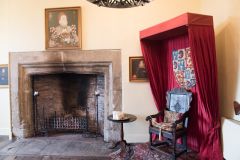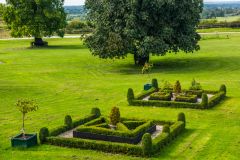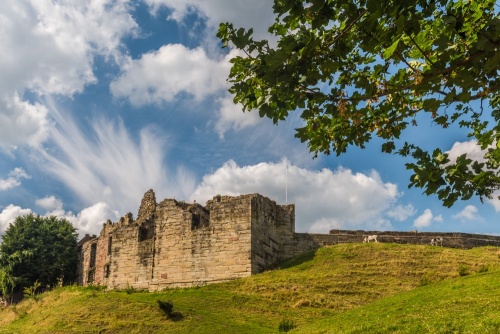
Tutbury Castle was begun shortly after the Norman Conquest by either Hugh d'Avranches or Henry de Ferrers. Avranche held the manor first, but he exchanged it for the Earldom of Chester, and in 1071 Tutbury was granted to Ferrers by William the Conqueror. One of the Norman lords erected a motte and bailey castle on a high ridge over the River Dove.
The Ferrers family had a tumultuous relationship with the crown, and Tutbury suffered as a result. In 1173 the Ferrers, now Earl of Derby, sided with Prince Henry ('the Young King') against Henry II, and Tubury was besieged and badly damaged. The Ferrers rebelled again in 1264, following Simon de Montfort in his bid to oust Henry III. Once again Tutbury was besieged, and again it suffered damage at the hands of the royal troops.
Henry III seized Tutbury and gave it to his son Edmund, the Earl of Lancaster. The castle was sacked yet again in 1322 but it eventually became a royal fortress when Henry IV came to the throne.
In 1449 Henry VI gave the castle to Margaret of Anjou as part of her marriage settlement, and it was during Queen Margaret's ownership that the North Tower, also known as Queen Margaret's Tower, was built.
The most famous episode in the long and often bloody history of Tutbury came in the Elizabethan era, when Mary, Queen of Scots was imprisoned here, not once, not twice, or three times, but on four separate occasions. It was during her imprisonment at Tutbury that Mary was implicated in the Babington Plot to overthrow Queen Elizabeth I, a link that finally convinced Elizabeth to order her rival's execution.
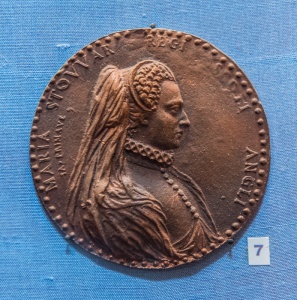
medallion in the museum
Tutbury was besieged yet again during the Civil War. A Royalist garrison repelled an attack by Parliament in 1643, but in 1646 a heavy artillery bombardment forced the castle defenders to surrender.
Parliament ordered the castle slighted so it could not be used against them, but the 'slighting' of Tutbury was only partially completed, and the castle has never been allowed to become a complete ruin and was never abandoned.
The castle is composed of a pair of outer baileys flanking a D-shaped inner bailey. The oldest part of the castle is a Norman chapel, evident from foundations alone.
Apart from that, the oldest remnant is the early 14th-century gate tower in the inner bailey. There is a medieval herb garden laid out on the lawn, an authentic recreation of a Tudor garden, a beautifully preserved Great Hall, and the King's Bedroom. The tower that now tops the motte is not original; it was built in the 18th century as a folly.
Ghosts at Tutbury
Tutbury Castle is a popular destination for ghost hunters and folks interested in the paranormal. Several ghosts have been reported, including a figure in full armour who commands visitors to 'get thee hence'.
The spectre of Mary, Queen of Scots has been sighted on numerous occasions; not surprising perhaps, considering that she was held - and mistreated - at Tutbury. Popular TV shows, including 'Most Haunted' have filmed episodes at Tutbury Castle, and there are regular ghost hunting events in the evenings.
Visiting
We came to Tutbury on a sunny afternoon in mid-September. You approach the castle up a curving drive to a fortified gateway, which gives access to the bailey. There is a rather incongruous modern tent erected inside the bailey for events, which rather detracts from the ambience. What is really striking is the sheer size of the castle bailey; the space is absolutely huge.
Directly in front of you is the original motte, with the 18th-century folly emulating a ruined circular tower. The motte offers simply stunning views over the town and the valley below. It also looks down on the King's Lodging, built for Charles.
One part of the King's Lodging is now a tea shop, but if you go through the shop and climb the stairs you find yourself in the museum, with artefacts discovered during excavations. There are a large number of coins and medallions, including several connected with Mary, Queen of Scots.
Beside the King's Lodging is the South Tower. Although the tower is roofless, you can climb to the top of the battlements, and look down inside the tower. What is most striking is the clearly exposed stone vaulting that supported the storage areas at the base of the tower.
We thoroughly enjoyed visiting Tutbury Castle; the location is superb, the surviving medieval towers are impressive, and the museum really does a good job of exploring the castle's long and often bloody history.
About Tutbury Castle
Address: Castle Street,
Tutbury,
Staffordshire,
England, DE13 9JF
Attraction Type: Castle
Website: Tutbury Castle
Location
map
OS: SK211 290
Photo Credit: David Ross and Britain Express
HERITAGE
 We've 'tagged' this attraction information to help you find related historic attractions and learn more about major time periods mentioned.
We've 'tagged' this attraction information to help you find related historic attractions and learn more about major time periods mentioned.
Historic Time Periods:
Find other attractions tagged with:
14th century (Time Period) - 15th century (Time Period) - 18th century (Time Period) - castle (Architecture) - Civil War (Architecture) - Elizabeth I (Person) - Elizabethan (Architecture) - Henry II (Person) - Henry III (Person) - Henry IV (Person) - Henry VI (Person) - Mary, Queen of Scots (Person) - Medieval (Time Period) - motte and bailey (Historical Reference) - Norman (Architecture) - Queen Elizabeth (Person) - Royalist (Person) - Tudor (Time Period) - William the Conqueror (Person) -
NEARBY HISTORIC ATTRACTIONS
Heritage Rated from 1- 5 (low to exceptional) on historic interest
Tutbury, St Mary's Priory Church - 0 miles (Historic Church) ![]()
Sudbury Hall - 3.9 miles (Historic House) ![]()
Catton Hall - 8.5 miles (Historic House) ![]()
Kedleston, All Saints Church - 9.4 miles (Historic Church) ![]()
Kedleston Hall - 9.4 miles (Historic House) ![]()
Derby, St Werburgh's Church - 9.6 miles (Historic Church) ![]()
Pickford's House Museum of Georgian Life and Costume - 9.6 miles (Museum) ![]()
Calke Abbey - 9.8 miles (Historic House) ![]()
Nearest Holiday Cottages to Tutbury Castle:
Ashbourne, Derbyshire
Sleeps: 4
Stay from: £654 - 2184
More self catering near Tutbury Castle
